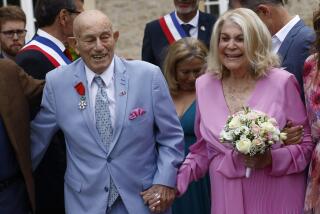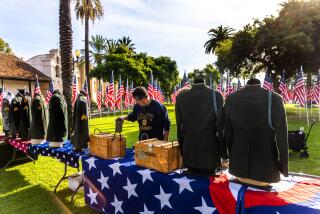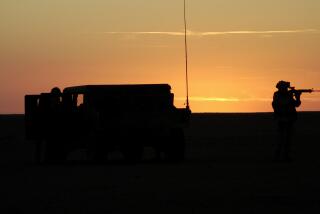Praise for a Worthy Pioneer
While keeping bedside vigil after his motherâs third cancer surgery last spring, Bill Garr just kept thinking to himself: âThis woman deserves a medal.â
Turns out 80-year-old Jean Claire Garr deserved two medals and a pin.
Surrounded by a circle of family and friends, standing proud before Navy Lt. Darriel Groen, Garr received the three military honors she never collected after World War II: The Victory Medal, a medal for Distinguished Service in the American Campaign and an Honorable Service lapel pin.
âOn behalf of the U.S. Navy, it is my honor to award these honors to Yeoman 1st Class Jean Garr,â Groen announced as Garr teared up and her husband of 58 years said, âSheâs one tough cookie, isnât she?â
The medals that were pinned to Garr on Saturday night at a celebration in Sierra Madre were given to every World War II serviceman with an honorable discharge.
But Garr was no serviceman. She was member of a small but bold corps of women who responded to emergency legislation in 1942 signed by President Franklin Roosevelt, allowing women to enlist in the Navy.
Known as the WAVES, short for Women Accepted for Voluntary Emergency Service, Garr was one of about 86,000 women who held an array of jobs in the States, mainly clerical positions, but some worked as control tower operators, postal clerks, mechanics, draftsmen and intelligence analysts. They filled posts normally held by sailors who were needed overseas.
âI was just one of the girls who went to work at a desk so that a man could be freed up to fight,â Garr said, recalling her three years of service as a secretary to a Navy captain and a commander based at Treasure Island in San Francisco.
Even today, she is surprised that her son and daughter would be interested enough in her service record to find her discharge papers in the family safe deposit box and contact Rep. David Dreier (R-San Dimas) to help collect her medals.
Medals were something âyou just didnât think aboutâ after the war, she said, adding that she never bothered to collect hers. Her childrenâs only piece of memorabilia has been an 8-by-10 grainy reprint of Garrâs smiling military photograph, a black-and-white portrait of a 22-year-old woman in a blue uniform jacket, light brown hair pinned back, a thick cascade of chin-length curls in the back.
âI just thought it would be a good opportunity to learn and travel,â she said. âWe all knew that something had to be done, and this is what I did.â
Garrâs is a story that is common among this group of World War II women, who six decades later Naval historians and others call the pioneers for enlisted women today.
âThose women of World War II, they just donât feel that what they did was any big deal,â said Barb Turner, president of the National WAVES organization. She estimates there are 10,000 World War II WAVES still alive, and her organization is working to collect their oral histories.
âThey have no idea that what they did back then paved the way for all who followed,â said Turner, who served in the Navy from 1975 to 1996.
It was the WAVESâ work at 900 Navy installations in the United States that gave women their first entry into military work apart from nursing.
Garr recalled boarding a train alone for a Naval training school in Milledgeville, Ga., where the Navy had set up a yeoman school at the former Georgia State College for Women. âWe could take one suitcase, but thatâs all we needed. They gave us our uniforms and everything else,â she said.
She remembers the womenâs version of boot camp: up at predawn hours, perfectly made beds, and uniform and dormitory inspections. She learned to march, salute and how to address higher-ups.
Then she was off to Hunter College in New York for more training. âThey taught us all about ships, the port, the starboard. We had to know all about the Navy and all their terminology for our work.â
She remembers the last name of the commander she worked for, but canât remember how to spell it. But she can tell you how to properly align carbon paper so that it doesnât slip in the typewriter.
At its peak, the World War II WAVES made up 55% of the Navy staff in Washington, D.C., 75% of personnel at the Navyâs Washington communication center and handled 80% of the serviceâs mail, said Capt. John Pruitt, commanding officer of the Naval Air Station at Pensacola, Fla., during a recent speech at a WAVES convention.
âJoining the Navy was a very socially daring thing for a woman to do at the time, even as a WAVE,â said Jack Green, historian and curator at the Naval Historical Center.
It was the sight of Jean Smith in her perfect Navy blue uniform stepping off the train in San Fransico that caught the eye of Bill Garr.
âShe was a very strong-willed girl. Period,â said Bill Garr, who worked at a San Francisco-area shipyard during the war. âWe didnât want to wait,â he said. They married in three months.
Bill Garr became a horse-racing radio announcer, working the Santa Anita, Hollywood Park and Del Mar circuits. Jean became, as Bill said, âThe Queen of Bradbury,â establishing her own real estate brokerage company in the town of Bradbury.
Growing up in Sierra Madre, the Garr kids, Bill Jr. and Jeannie, always knew there was something military about their mom. Jean had to fold her bedsheets in right angles. Bill remembers breakfast being served promptly at 7:30 a.m. The car departed for school at exactly 8 a.m. He remembers his mom coaching him during track meets to fight and never give up.
Bill said his wife found it easy to navigate the business of real estate in the 1970s, feeling confident working mainly among men.
Garr received one other medal Saturday, this made for her by Dr. Richard Nalick for âVictory Over Cancer, Strength and Courage.â He placed it around her neck like an Olympian. Two years ago, Garr was told she had six months to live.
âI do think the military gave her a certain strength and constitution, a will to live,â said her husband, who deep in his wallet still carries the original snapshot of his bride in uniform, the familyâ keepsake of their World War II WAVE.
âTo my sweet husband, with all my love,â she wrote in 1944.
More to Read
Sign up for Essential California
The most important California stories and recommendations in your inbox every morning.
You may occasionally receive promotional content from the Los Angeles Times.










